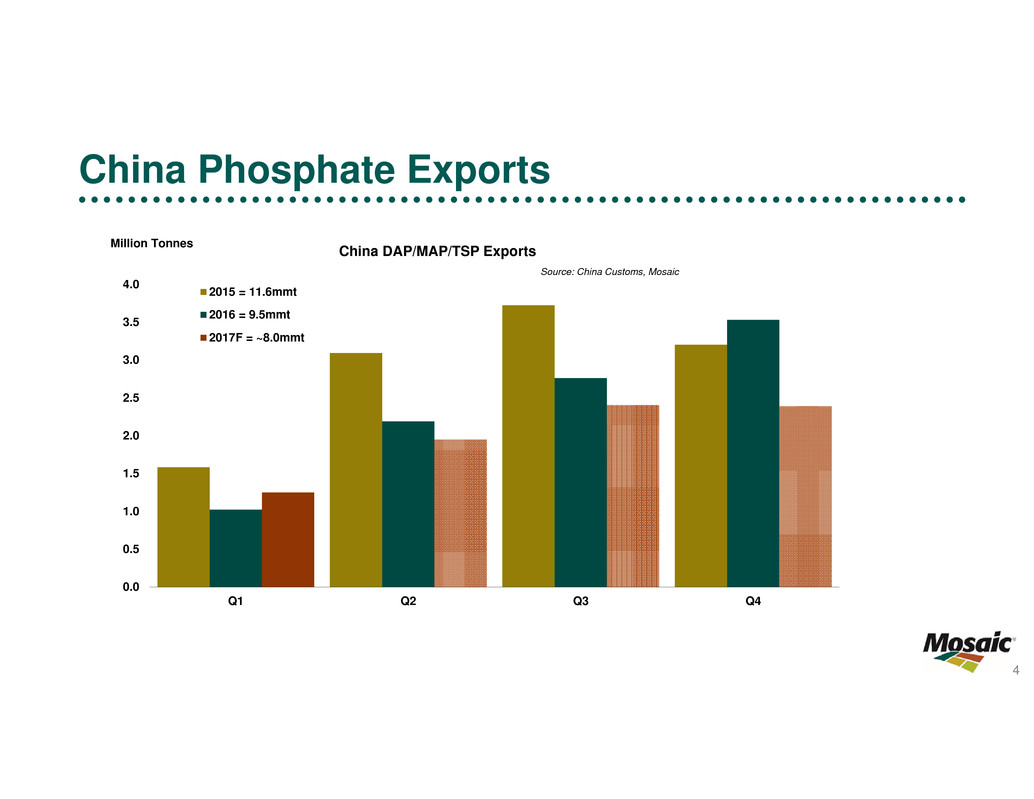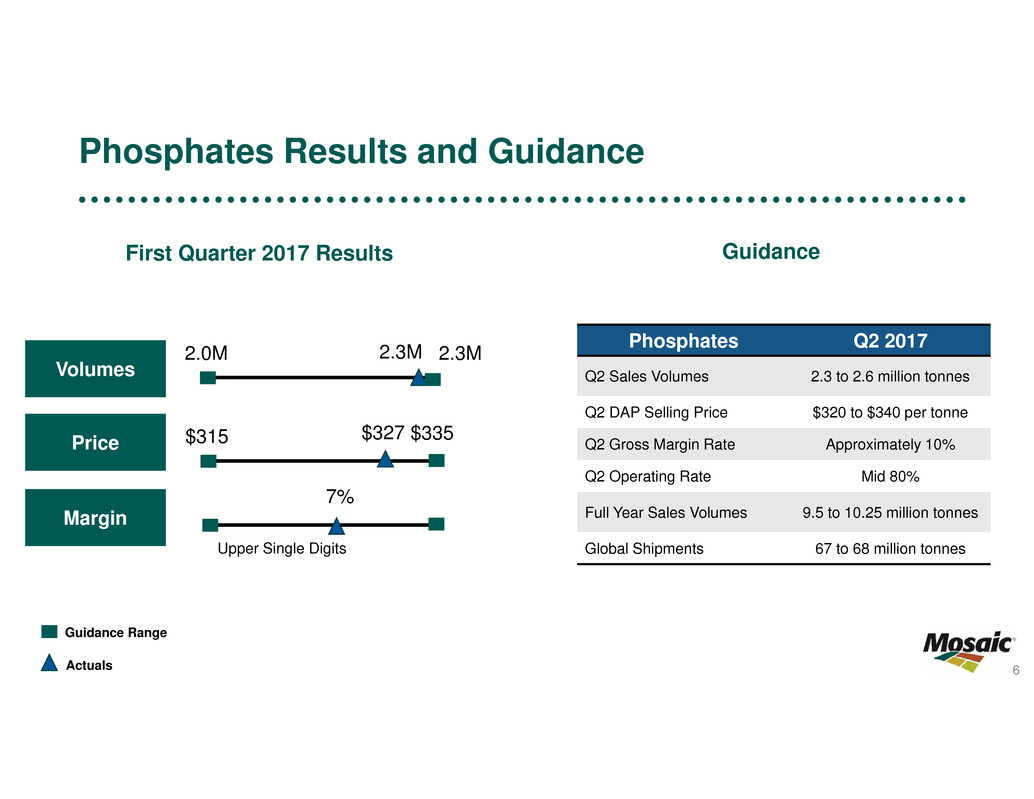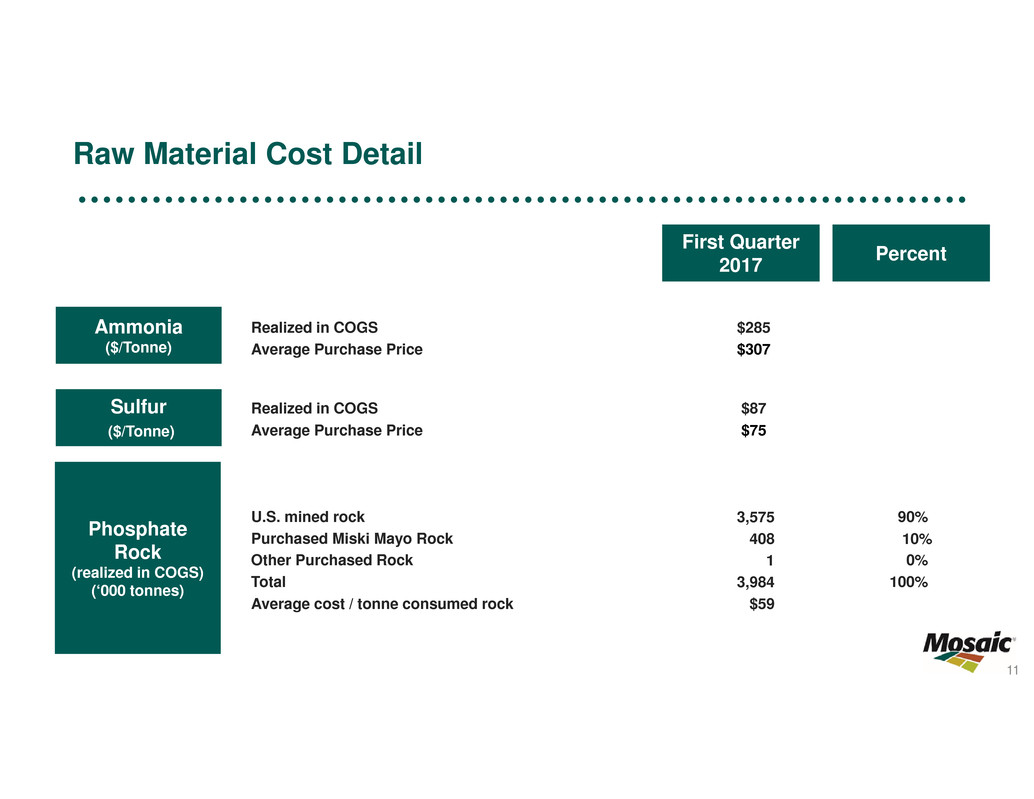Attached files
| file | filename |
|---|---|
| 8-K - 8-K - Q1 2017 EARNINGS CALL TRANSCRIPT AND SLIDES - MOSAIC CO | a8-kcy17xq1earningscalltra.htm |
| EX-99.1 - EXHIBIT 99.1 - Q1 2017 EARNINGS CALL TRANSCRIPT - MOSAIC CO | a1q2017earningstranscripte.htm |

Presenters:
Date:
Earnings Conference Call – First Quarter 2017
May 2, 2017
Joc O’Rourke, President and Chief Executive Officer
Rich Mack, Executive Vice President and Chief Financial Officer
Laura Gagnon, Vice President Investor Relations
The Mosaic Company

MOSAIC CONFIDENTIAL
Forward Looking Statements
Forward-Looking Statements
This document contains forward-looking statements within the meaning of the Private Securities Litigation Reform Act of 1995. Such statements include, but are not limited to, statements about our
proposed acquisition of the global phosphate and potash operations of Vale S.A. (“Vale”) conducted through Vale Fertilizantes S.A. (the “Transaction”) and the anticipated benefits and synergies of the
proposed Transaction, other proposed or pending future transactions or strategic plans and other statements about future financial and operating results. Such statements are based upon the current
beliefs and expectations of The Mosaic Company’s management and are subject to significant risks and uncertainties. These risks and uncertainties include but are not limited to risks and uncertainties
arising from the possibility that the closing of the proposed Transaction may be delayed or may not occur, including delays or risks arising from any inability to obtain governmental approvals of the
Transaction on the proposed terms and schedule, any inability of Vale to achieve certain other specified regulatory and operational milestones or to successfully complete the transfer of the Cubatão
business to Vale and its affiliates in a timely manner, and the ability to satisfy any of the other closing conditions; our ability to secure financing, or financing on satisfactory terms and in amounts sufficient
to fund the cash portion of the purchase price without the need for additional funds from other liquidity sources; difficulties with realization of the benefits of the proposed Transaction, including the risks that
the acquired business may not be integrated successfully or that the anticipated synergies or cost or capital expenditure savings from the Transaction may not be fully realized or may take longer to realize
than expected, including because of political and economic instability in Brazil or changes in government policy in Brazil; the predictability and volatility of, and customer expectations about, agriculture,
fertilizer, raw material, energy and transportation markets that are subject to competitive and other pressures and economic and credit market conditions; the level of inventories in the distribution channels
for crop nutrients; the effect of future product innovations or development of new technologies on demand for our products; changes in foreign currency and exchange rates; international trade risks and
other risks associated with Mosaic’s international operations and those of joint ventures in which Mosaic participates, including the risk that protests against natural resource companies in Peru extend to or
impact the Miski Mayo mine, the ability of the Wa’ad Al Shamal Phosphate Company (also known as MWSPC) to obtain additional planned funding in acceptable amounts and upon acceptable terms, the
timely development and commencement of operations of production facilities in the Kingdom of Saudi Arabia, the future success of current plans for MWSPC and any future changes in those plans;
difficulties with realization of the benefits of our long term natural gas based pricing ammonia supply agreement with CF Industries, Inc., including the risk that the cost savings initially anticipated from the
agreement may not be fully realized over its term or that the price of natural gas or ammonia during the term are at levels at which the pricing is disadvantageous to Mosaic; customer defaults; the effects of
Mosaic’s decisions to exit business operations or locations; changes in government policy; changes in environmental and other governmental regulation, including expansion of the types and extent of
water resources regulated under federal law, carbon taxes or other greenhouse gas regulation, implementation of numeric water quality standards for the discharge of nutrients into Florida waterways or
efforts to reduce the flow of excess nutrients into the Mississippi River basin, the Gulf of Mexico or elsewhere; further developments in judicial or administrative proceedings, or complaints that Mosaic’s
operations are adversely impacting nearby farms, business operations or properties; difficulties or delays in receiving, increased costs of or challenges to necessary governmental permits or approvals or
increased financial assurance requirements; resolution of global tax audit activity; the effectiveness of Mosaic’s processes for managing its strategic priorities; adverse weather conditions affecting
operations in Central Florida, the Mississippi River basin, the Gulf Coast of the United States or Canada, and including potential hurricanes, excess heat, cold, snow, rainfall or drought; actual costs of
various items differing from management’s current estimates, including, among others, asset retirement, environmental remediation, reclamation or other environmental regulation, Canadian resources
taxes and royalties, or the costs of the MWSPC, its existing or future funding and Mosaic’s commitments in support of such funding; reduction of Mosaic’s available cash and liquidity, and increased
leverage, due to its use of cash and/or available debt capacity to fund financial assurance requirements and strategic investments; brine inflows at Mosaic’s Esterhazy, Saskatchewan, potash mine or other
potash shaft mines; other accidents and disruptions involving Mosaic’s operations, including potential mine fires, floods, explosions, seismic events, sinkholes or releases of hazardous or volatile chemicals;
and risks associated with cyber security, including reputational loss, as well as other risks and uncertainties reported from time to time in The Mosaic Company’s reports filed with the Securities and
Exchange Commission. Actual results may differ from those set forth in the forward-looking statements.
2

MOSAIC CONFIDENTIAL
Executive Summary
3
Several Items
Impacted First
Quarter 2017
Results
Managing
Costs and Capital
Markets Have
Improved
Expect Better
Profitability in Q2
and H2 2017

MOSAIC CONFIDENTIAL
China Phosphate Exports
4
0.0
0.5
1.0
1.5
2.0
2.5
3.0
3.5
4.0
Q1 Q2 Q3 Q4
Million Tonnes
China DAP/MAP/TSP Exports
2015 = 11.6mmt
2016 = 9.5mmt
2017F = ~8.0mmt
Source: China Customs, Mosaic

MOSAIC CONFIDENTIAL
Financial Results Review
5

MOSAIC CONFIDENTIAL
Phosphates Results and Guidance
6
GuidanceFirst Quarter 2017 Results
Volumes
Price
Margin
2.0M 2.3M2.3M
$315 $335$327
Upper Single Digits
7%
Phosphates Q2 2017
Q2 Sales Volumes 2.3 to 2.6 million tonnes
Q2 DAP Selling Price $320 to $340 per tonne
Q2 Gross Margin Rate Approximately 10%
Q2 Operating Rate Mid 80%
Full Year Sales Volumes 9.5 to 10.25 million tonnes
Global Shipments 67 to 68 million tonnes
Guidance Range
Actuals

MOSAIC CONFIDENTIAL
Potash Results and Guidance
7
Potash Q2 2017
Q2 Sales Volumes 2.0 to 2.3 million tonnes
Q2 MOP Selling Price $170 to $185 per tonne
Q2 Gross Margin Rate Low 20 percent
Q2 Operating Rate Low 90 percent*
Full Year Sales Volumes 8.0 to 8.75 million tonnes
Global Shipments 62 to 63 million tonnes
GuidanceFirst Quarter 2017 Results
Volumes
Price
Margin
2.15M 2.3M
Guidance Range
Actuals
2.0M
$160 $180$172
17%
*Operating rate guidance reflects lower operational capacity at the Colonsay mine.
~20%

MOSAIC CONFIDENTIAL
International Distribution Results and Guidance
8
GuidanceFirst Quarter 2017 Results
Volumes
Margin/Tonne
1.2M 1.5M
~$20 $21
International Distribution Q2 2017
Q2 Sales Volumes 1.4 to 1.7 million tonnes
Q2 Gross Margin per Tonne Approximately $20
Full Year Sales Volumes 7.0 to 7.5 million tonnes
Guidance Range
Actuals
1.3M

MOSAIC CONFIDENTIAL
Other Full-Year Guidance
9
Consolidated Full-Year 2017
Total SG&A $295 to $310 million
Capital Expenditures and Equity Investments $950 million to $1.05 billion
Effective Tax Rate Upper single digits
Potash 2017
Full Year Canadian Resources Taxes $85 to $135 million
Full Year Brine Management Costs $160 to $180 million

MOSAIC CONFIDENTIAL
Closing Remarks and Appendix
10

MOSAIC CONFIDENTIAL
Raw Material Cost Detail
11
Ammonia
($/Tonne)
First Quarter
2017 Percent
Realized in COGS $285
Average Purchase Price $307
Realized in COGS $87
Average Purchase Price $75
Sulfur
($/Tonne)
Phosphate
Rock
(realized in COGS)
(‘000 tonnes)
U.S. mined rock 3,575 90%
Purchased Miski Mayo Rock 408 10%
Other Purchased Rock 1 0%
Total 3,984 100%
Average cost / tonne consumed rock $59

MOSAIC CONFIDENTIAL
Earnings Sensitivity to Key Drivers(a)
12
(a) These factors do not change in isolation; actual results could vary from the above estimates
(b) Assumes no change to KMAG pricing
2017 Q1
Actual Change
2017 Q1
Margin %
Actual
% Impact on
Segment
Margin
Pre-Tax
Impact
Quarterly
EPS Impact
Marketing
MOP Price ($/tonne)(b) $172 $50 22% 24% $99 $0.25
Potash Volume
(thousand tonnes) 1,973 500 22% 12% $49 $0.13
DAP Price ($/tonne) $327 $50 7% 14% $114 $0.29
Phosphate Volume
(thousand tonnes) 2,272 500 7% 4% $30 $0.08
Raw Materials
Sulfur ($/lt) $87 $50 7% 5% $45 $0.12
Ammonia ($/tonne) $285 $50 7% 3% $26 $0.07

MOSAIC CONFIDENTIAL
Phosphate Raw Material Trends
13
0
50
100
150
200
250
300
350
400
450
500
Q2
2015
Q3
2015
Q4
2015
Q1
2016
Q2
2016
Q3
2016
Q4
2016
Q1
2017
Q2
2017F
Realized Costs Market Prices
0
25
50
75
100
125
150
175
Sulfur
(long
ton)(p)
Q2
2015
Q3
2015
Q4
2015
Q1
2016
Q2
2016
Q3
2016
Q4
2016
Q1
2017
Q2
2017F
Realized Costs Market Prices
Ammonia Sulfur
($/tonne) ($/tonne)
1. Market ammonia prices are average prices based upon Tampa C&F as reported by Fertecon
2. Market sulfur prices are average prices based upon Tampa C&F as reported by Green Markets
3. Realized raw material costs include:
~$20/tonne of transportation, transformation and storage costs for sulfur
~$35/tonne of transportation and storage costs for ammonia
1 2

MOSAIC CONFIDENTIAL
Global Potash Shipment Forecasts by Region (May 2, 2017)
14
Muriate of Potash
Million Tonnes (KCl) 2015 2016
Low
2017F
High
2017F Comments
China 15.9 13.3 13.8 14.0
Implied shipments plunged last year as a result of a 2.6 mmt decline in imports and lower domestic production. The
drop in shipments coupled with a modest increase in on-farm use implies a drawdown of channel inventories from
lofty levels at the end of 2015. Shipments are forecast to increase this year due to another moderate gain in on-
farm use (area lost to corn will get planted to other K-using crops) and a smaller decline in channel stocks. Imports
are forecast to rebound from 6.8 to 7.8 mmt.
India 4.0 3.9 4.1 4.3
Shipments stagnated as distributors worked through high stockpiles last year. A modest increase is forecast for
this year despite a reduction in the 2017/18 potash subsidy and the expectation of a moderate increase in retail
potash prices. Lower international prices, a stronger rupee, increases in minimum support prices, and initial
forecasts for a normal monsoon underpin solid on-farm demand.
Indonesia/Malaysia 4.3 4.8 5.0 5.2
Sentiment and shipments began to pick up during the tender season in the latter part of last year as improved
fundamentals – normal rainfall, lower K prices and a recovery in palm oil prices – took hold. We expect stronger
fundamentals will continue to drive moderate gains in 2017.
Europe/FSU 10.6 10.2 10.6 10.8
Shipments in 2017 are projected to rebound to 2015-like levels mainly due to the ebbs and flows resulting from
swings in channel inventories in Europe as well as continued strong growth in Russia, Ukraine and other FSU
countries (albeit from a relatively low base).
Brazil 8.7 9.1 9.6 9.8
Our 2017 forecast was revised up to nearly 9.7 mmt. Net imports are projected to reach a record 9.2 mmt and
domestic production/shipments are expected to remain at 0.5 mmt. Q1 shipments got off to a fast start -- imports
totaled 1.7 mmt, up 23% from a year earlier and production was up 9%. The demand story is unchanged - both
agronomic and economic drivers remain constructive.
North America 8.9 9.4 9.2 9.4
Shipments last fall (Jul-Dec) jumped 19% to a modern era record of 4.7 mmt. As a result, our 2016 estimate was
revised up to 9.4 mmt. Prospects for the 2017 remain positive based on record U.S. soybean area, a moderate
drop in corn area, and consistent reports of many farmers rebuilding soil potassium levels. Spring (Jan-Jun) and
fall (Jul-Dec) shipments each are projected to top 4.6 mmt.
Other 9.3 10.0 9.8 9.9
Demand outside the “Big Six” regions increased a solid 7+% as a result of broad-based gains in other Asian, other
Latin American, and African countries. Most countries are expected to hold gains from last year given continued
moderate agricultural commodity prices and lower potash prices.
Total 61.6 60.7 62.1 63.4
Our current 2017 shipment forecast is 62.6 mmt, an increase of 3.1% or 1.9 mmt from last year. Gains in the “Big
Six” consuming regions account for all of the projected increase for reasons noted above. These six regions
account for about 85% of global shipments.

MOSAIC CONFIDENTIAL
Global Phosphate Shipment Forecasts by Region (May 2, 2017)
15
Million Tonnes
DAP/MAP/NPS*/TSP 2015 2016E
Low
2017F
High
2017F Comments
China 19.8 18.4 18.0 18.3
We have trimmed our forecast for 2017 – rather than flat, now showing a modest decline – as early reports on spring
season volumes have come in below our previous expectations, with farm economics coming under some strain
from reduced government support measures.
India 9.2 9.2 9.3 9.5
We continue to project a modest uptick in shipments in 2017, underpinned by the following: DAP subsidy was cut
only notionally, farmer sentiment is strong after a good Rabi season, inventories (particularly in the private channels,
ports and at retailers) are low, appreciation of the rupee, prospects of another ‘normal’ monsoon. We project DAP
imports in calendar 2017 will jump by over a million tonnes y-o-y to ~5.4mmt.
Other Asia/Oceania 9.1 8.8 9.3 9.5
Our 2017 forecast is unchanged, and we continue to believe that there is upside to the forecast if the positive farm
economics that prevailed in 2016 persist through 2017 and any potential development of an El Niño weather pattern
is delayed until late-2017.
Europe and FSU 4.7 5.2 5.1 5.3
Our 2017 forecast is cut modestly after reports of a lackluster spring season in the EU, while we expect Russian
demand to moderate somewhat – with ~10% y-o-y growth – after surging 40% in 2016.
Brazil 6.9 7.8 8.5 8.7
We continue to call for record-busting shipments in 2017, though y-o-y growth in high-analysis phosphate shipments
is expected to fall a point short of the 13% growth seen in 2016. Farm economics remain very attractive despite the
relative strength of the real in 2017, though the recent weakening of soybean prices, the current slow pace of selling
this year’s harvest and the recent lull in fertilizer buying has the potential to trim our shipment forecast if they persist
through May.
Other Latin America 2.8 3.7 3.6 3.7
Demand surprised to the upside in 2016, particularly in Argentina where shipments doubled y-o-y to 1.4mmt. We
have left our forecast for 2017 unchanged, calling for demand to remain flat or slightly lower. The demand drivers of
2016, namely good farmer economics, remain largely in place, though sentiment is not as strong as a year ago.
North America 8.9 9.2 9.3 9.4
The fall season was better than expected in 2016 as farmers stepped in to replace large nutrient withdrawals with
historically low-cost phosphate. Because of this, we believe that 2017 started with very low channel inventories,
which drove record Jan-Apr import volumes. Reports from the field indicate that spring application rates remain
strong, and as such we anticipate broadly flat y-o-y shipments (though this will obviously hinge on farm
economics/ag commodity prices this fall).
Other 3.2 3.8 3.7 3.9
Our forecast for 2017 is little-changed. We expect a modest pullback in Middle East volumes after strong growth in
2016, which should be easily offset by the remarkable demand story that continues to spread across Africa.
Total 64.6 66.2 66.8 68.3 Our shipment forecast for 2017 is now at 67-68 million tonnes with a point estimate of 67.3 mmt.
